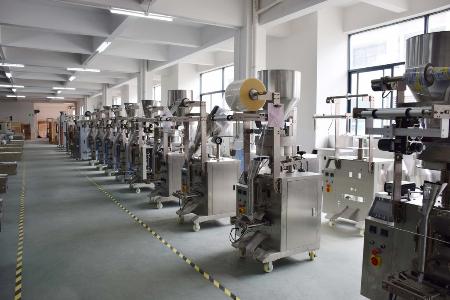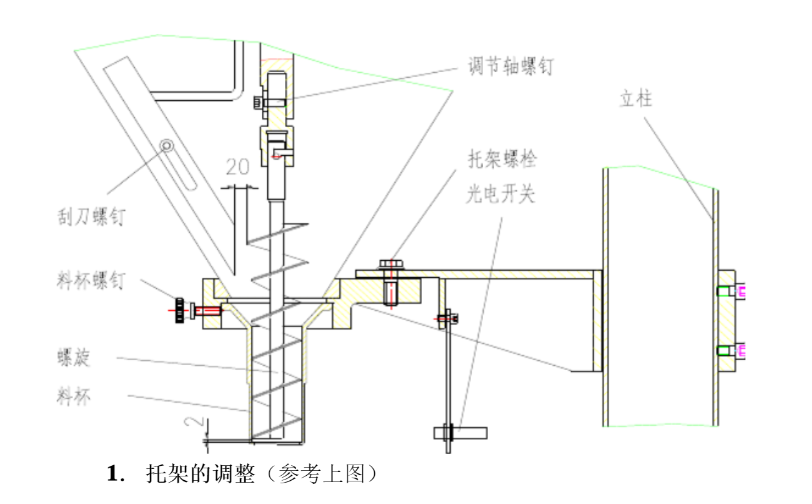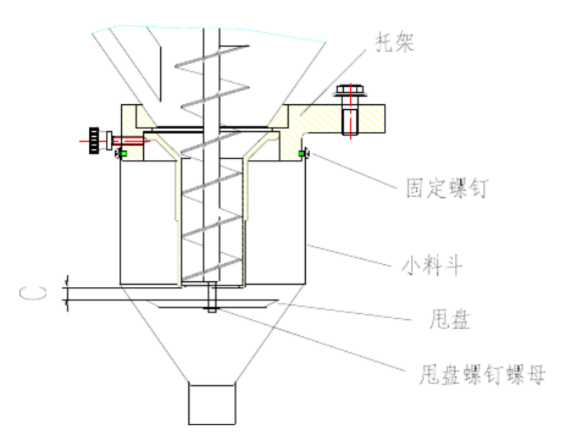
In the rapidly evolving global industry and with increasing demands for product quality, automatic packaging equipment has become an indispensable assistant for many manufacturers in enhancing productivity and product quality. Particularly in the field of powder industries, the use of small powder automatic packaging machines is becoming increasingly common. Here, we are pleased to provide you with a detailed analysis of the operating principle, unique advantages, and the significant role that such small powder automatic packaging machines play in actual packaging processes.
First, let's understand the basic working principle of this small powder automatic packaging machine. It adopts cutting-edge mechanical technology and electronic control systems, thereby achieving a fully automated packaging process. Specifically, its workflow mainly includes the following five steps:
We recommend to you an excellent and efficient small powder automatic packaging machine, which, compared to the traditional manual packaging method, has a series of unique competitive advantages:
Regarding the scope of application of this equipment, we will elaborate in detail for you as follows:
This small powder automatic packaging machine has a wide application in powder-related industries covering areas such as chemical, food, pharmaceutical, construction materials, and more. Here are some specific examples of its application scenarios:
The small powder automatic packaging machine greatly enhances production efficiency and product quality through intelligent automation, while reducing resource waste and labor costs, and significantly enhancing safety during the production process. It has been widely used in the powder field, providing efficient and stable packaging solutions for various enterprises. With the trend of technological advancement, we firmly believe that small powder automatic packaging machines will receive deeper development and wider application in the future.
In our daily lives, powdered food products are ubiquitous, such as coffee, various seasoning powders, infant formula, flour, pharmaceutical powders, baking soda, table salt, lotus root powder, rice flour, milk tea powder, ice cream powder, and so on. With the continuous rapid development of China's economy, the demand for powdered products is also increasing year by year, posing significant challenges to production enterprises. They must constantly improve production efficiency, and the most direct and effective way is to purchase more equipment. Therefore, the importance of multi-functional powder packing machine equipment is highlighted. Today, let us explore the working principle of multi-functional powder packaging machine equipment and how it completes the task of powder packaging.
When purchasing powder packaging machines, we should focus on the overall strength of the manufacturers and fully understand the working principle of multi-functional powder packaging machine equipment.
The principle of operation of the multifunctional powder packaging machine is mainly for packaging products and providing protection, and its main principle of operation is to install the feeding barrel inside the packaging machine, fill the material into the bags, and perform top-down vertical filling. The packaging machinery equipment mainly consists of weighing equipment, transportation system, horizontal and vertical sealing equipment, forming machine, filling tube, and film tensioning mechanism. Thus, the principle of operation of the multifunctional powder packaging machine is to guide the film from the rolls placed on the supporting equipment through the guide bars, then through the tensioning device and photoelectric detection control device to determine the position of the packaging material pattern, and wrap it first, on the film roll, the tube is wound around the outer surface of the filling tube. The multifunctional powder packaging machine uses a vertical heat sealer to vertically seal the film wound on the cylindrical shape at the interface, then moves the cylindrical film to the horizontal heat sealer and horizontally seals it to form the bag body. Finally, the measuring device of the multifunctional powder packaging machine will fill the measured item through the upper filling hose into the packaging bag, then sealed by the horizontal sealer and cut in the middle, forming the packaging bag unit, and also forming the bottom seal of the next drum bag.
This is the principle of operation of the multifunctional powder packaging machine. Today's packaging manufacturing industry and processing field have a much wider scope than we can imagine. Based on the current market situation, there are many different types of packaging equipment on the market that require scientific and reasonable operations management for different types of packaging equipment.
For many years, the Chinese powder packaging machine market has maintained a stable and rapid growth trend. According to market research, the reason why the Chinese market attracts attention is mainly because the sales volume in the Chinese market as a proportion of the global market continues to increase, which undoubtedly opens up broad development prospects for domestic powder packaging machine enterprises.
Currently, powder packaging machines are widely used not only in pharmaceutical production but also in the food industry, daily chemical industry, and everyday chemical industry. Chinese powder packaging technology, based on the existing foundation, is constantly improving, aiming to provide ease of use, emphasize the perfect combination of product quality and appearance, and make outstanding contributions to the development of the powder packaging industry in our country.
Leading experts in the field recognize that the goal of Chinese powder packaging machines is to focus on industry research, focus on providing solutions for processing typical parts in the powder packaging equipment industry, and research and develop typical automatic opening box devices.
However, we must also clearly recognize the differences between Chinese powder packaging machine enterprises and well-known international enterprises. These differences cover many aspects of the packaging industry, including basic packaging industry technologies, innovation capabilities, promotion capabilities, service levels, and more.
For example, after purchasing a powder packaging machine, we also need to pay attention to its daily maintenance and care to ensure the normal and stable operation of the equipment and effectively extend the service life of the equipment. Below are several key issues to consider in the maintenance of the powder packaging machine:
This packaging machine adopts advanced modular design concept, with its basic configuration including the main unit and the check feedback electronic scale. The main unit is responsible for precise quantitative filling operations, while the electronic scale performs the crucial task of verifying and providing feedback for error correction signals. Additionally, various optional accessories are available according to the specific needs of users, such as automatic feeding devices, bagging devices, anti-leakage devices, and sealing devices, all of which help users improve efficiency, enhance quantitative accuracy, and increase overall automation level.
This machine employs a microcomputer control system and efficient hybrid stepper motor drive technology, ensuring stability, reliability, and high repeatability accuracy of equipment operation. It can switch between two working modes, namely fixed volume or fixed quantity. Moreover, the discharging process is controlled by photoelectric switches, free from interference from external environmental factors. Parts in direct contact with materials are manufactured using high-quality stainless steel material, possessing excellent corrosion resistance and causing no contamination to materials. Simply by replacing the metering screw components, different materials and specifications of packaging requirements can be met in less than 10 minutes. This machine is equipped with many practical functions such as keyboard setting, automatic quantitative filling, weighing feedback, automatic error correction, over-limit alarm, material level control, automatic material clearing, electronic scale overload protection, counting, and more. It is widely applicable in the field of quantitative packaging of powdery and granular materials, such as pesticides, veterinary drugs, feed, flour, additives, condiments, and other industries.
The control part of this machine mainly consists of several components including the main control board, sensors, electrical control board, drive power supply, operation keyboard, photoelectric switch, and material level switch. Among them, the main control board serves as the control core, responsible for receiving weight signals transmitted by sensors and converting them into electrical signals, which are then transmitted to the drive power supply to drive the stepper motor. The keyboard is used for setting, modifying, and operating various parameters of the machine, the photoelectric switch is used to control the discharging process, the material level switch is used to monitor the material level height in the hopper, and the electrical control board is responsible for controlling the operation of the entire machine's power supply, stirring motor, and automatic feeding motor.
Regarding Inspection and Debugging
We have conducted strict debugging and inspection of each part of the equipment before it leaves the factory. However, during transportation and handling, fasteners may loosen or positions may change slightly; moreover, when replacing filling parts, relevant components also need to be adjusted accordingly. In order to ensure that you can use this product smoothly, please follow the steps below for inspection and debugging before putting it into formal use.
Regarding the adjustment of the bracket, we suggest you follow these steps: First, attach the screw to the adjusting shaft (similar to installing a standard pendant light bulb); then, rotate the screw approximately 90° each time and place the cup on the screw. Next, carefully observe whether the gap between the cup mouth and the bracket is uniform. If you notice any deviation in the gap, it's time to adjust the bracket. Before doing so, loosen the bracket bolts (do not completely loosen them, just enough so that the bracket can be gently tapped with a wooden stick). Next, you can use a wooden stick to tap the parts of the bracket with larger gaps until the cup can smoothly fit onto the screw at any position. Once this is achieved, tighten the bracket bolts.

For adjusting the height of the screw, we recommend the following method: First, place the cup on the screw and observe the position of the screw bottom, ensuring that it is approximately 2 millimeters away from the bottom edge of the cup (refer to the diagram for specific measurements). Then, open the observation window on the right side of the hopper cover, loosen the adjustment shaft screws, and evenly fix the cup in the appropriate position using the three cup screws. Afterwards, you can move the adjustment shaft up and down by hand, and when the screw height reaches the desired state, be sure to tighten the adjustment shaft screws.

Regarding the adjustment of the scraper position, we suggest performing this operation when replacing the screw. Typically, the distance between the scraper and the screw should be maintained at around 20 millimeters (refer to the diagram for specific measurements). To adjust, first loosen the scraper screws, then push the scraper up or down to the desired position based on your needs, and finally tighten the scraper screws.
As for adjusting the photoelectric switch, we have accurately adjusted its sensitivity before leaving the factory. However, if you find that the current setting does not meet your requirements, you can make slight adjustments yourself. The specific operation method is to press the "Settings" key on the keyboard to display "bSZ" on the left window, then use a screwdriver to rotate the screw at the rear of the photoelectric switch while covering the photoelectric switch with your hand. The red indicator light will illuminate. Once the distance is adjusted to the appropriate level, press the "Exit" key again to return to normal working mode.
In the daily use process, to ensure you can enjoy long-term use of this equipment, we provide some suggestions for equipment maintenance and care.
The working principle of the powder packaging machine covers the following key steps:
In addition, the powder packaging machine is equipped with a precision control system. For example, the electronic scale provides weight feedback through weighing sensors, and the microcomputer controller adjusts motor speed and drop height based on this data to achieve precise measurement. The powder packaging machine is suitable for packaging various powdered products, including pharmaceuticals, milk powder, coffee, and more, with high accuracy and reliability.
Before commencing the packaging process, it's essential to accurately measure the powder to ensure consistent quantities in each bag. To achieve this, powder packaging machines typically employ either fixed-volume or weight-based measurement methods.
In the fixed-volume method, the packaging machine utilizes devices like rotating screws or blades to lift or compress the powder, which is then conveyed into the bags. On the other hand, in the weight-based method, the packaging machine utilizes weight sensors for precise measurement. These sensors automatically adjust the powder's weight to ensure consistency in each bag's
Next, the packaging machine will fill the powder into the pre-prepared bags. Before filling, the bags need to be moved to the designated filling area, where the valve is then opened downward to allow the powder to flow into the bag. Once the filling operation is complete, the valve will automatically close.
During the powder filling process, it's crucial to ensure that the entire bag is uniformly filled without any irregularities. Accumulation of powder inside the bag should be avoided as the uniform distribution of powder inside the bag directly impacts the quality of the packaging and the density of the powder.
After filling is complete, it's essential to seal the bags tightly to prevent powder spillage. Packaging machines typically utilize two techniques for sealing: heat sealing or cold sealing.
During heat sealing, the bag is guided to the position of the heat sealing strip, where it undergoes sealing. On the other hand, cold sealing involves sealing by pressing the bag tightly. The choice between heat sealing and cold sealing depends on the material of the bag and the type of powder being packaged.
Overall, a powder packaging machine achieves powder packaging through a series of processes such as powder measurement, filling, and sealing. With its advanced automation technology and precise measurement methods, powder packaging machines have found wide applications in modern industrial fields.
A powder packaging machine is a comprehensive device specifically designed for packaging powder products. It integrates functions such as measurement, filling, sealing, and conveying. During operation, the powder packing machine follows the basic principles of fixed-volume feeding and static weighing feedback. This machine uses specially designed motors to operate according to preset packaging specifications. Subsequently, the main control board computer calculates the feeding signal based on the preset weight parameters. Once this signal is received, the equipment completes the entire process of feeding and filling at high speed. After filling, the bag filled with material is placed on the weighing feedback platform for the computer to read and compare the corresponding weighing values with theoretical values, and then adjust accordingly. In the next feeding cycle, the equipment operates based on the feedback correction value obtained in the previous cycle. This cycle repeats until the desired measurement effect is achieved. This measurement mode is suitable for various packaging specifications and ensures high accuracy. Powder packaging machines are widely used in the packaging of various powder products such as medicines, milk tea, milk powder, coffee, monosodium glutamate, glucose, solid beverages, plastic particles, and seasonings. For powder materials that are easy to flow or have poor flowability, it can automatically complete a series of complex work processes such as measurement, bag clamping, filling, sealing, bag sewing, and conveying. It has the advantages of high precision, strong reliability, and minimal wear and tear.